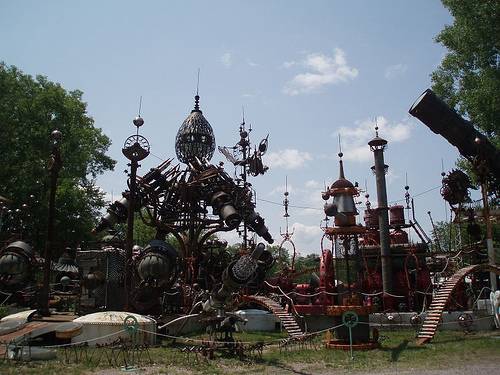
A “magic tap” continuously fills a basin in El Puerto de Santa María, Spain. How is this possible?

A “magic tap” continuously fills a basin in El Puerto de Santa María, Spain. How is this possible?
Amazing Stories was full of, well, amazing stories, but Richard Sharpe Shaver insisted that his were true. Between 1943 and 1948, Shaver and editor/publisher Ray Palmer told of cavern cities filled with evil robots that kidnapped and tortured unwary humans. Shaver insisted he had been a prisoner for several years.
Strangely, the first story brought a flood of excited letters corroborating Shaver’s tale. One woman claimed she had been abducted from a Paris subbasement and raped and tortured before good robots freed her. “Shaver Mystery Club” chapters began to spring up, and Amazing gained about 50,000 subscribers.
The stories petered out as the sensation ran its course, though the clubs persisted into the late 1950s. By the 1970s, Shaver was insisting that certain rocks were “books” created by ancient Atlanteans. Today it seems he was not a misunderstood visionary but a troubled schizophrenic with a compelling imagination.

The Forevertron is the largest scrap metal sculpture in the world. Salvage expert Tom Every spent decades collecting 320 tons of antique machinery, including dynamos built by Thomas Edison and an actual decontamination chamber from the Apollo project. It’s in southern Wisconsin.
In 1961, three prospectors in California found a sparkplug encased in solid rock.
It was originally thought to be 500,000 years old, which would put it in a class with the Kingoodie Hammer and the Dorchester Pot.
More recent investigations say the “rock” is just a concretion of iron oxide produced by the rusting plug, which may date only from the 1920s … but discoverer Mike Mikesell says he destroyed a diamond-edged blade in cutting through it.

You think your job’s bad. This was carved by hand from solid rock.
India has more than 1,200 such structures, the earliest dating to 8000 B.C.

The world’s largest food fight takes place each year on the last Wednesday in August, when the town of Buñol, Spain, holds its annual tomato festival. Local trucks dump more than 100 metric tons of overripe tomatoes into the streets, and there’s a general free-for-all among up to 25,000 people.
Reportedly, when it’s over, rivers of tomato juice up to 12 inches deep run through the town, and area fire engines hose down the streets.
This has been going on since 1944, and apparently it has no political or religious significance — they do it just for fun.
If you visited Spain in January 2000, you needed a tin umbrella: Chunks of ice weighing up to 6.6 pounds fell out of a cloudless sky for 10 days.
No one knows how the ice formed. The chunks resembled hailstones, but no thunderstorm was present.
Planetary geologist Jesus Martinez-Frias dubbed the stones megacryometeors, and more than 50 have been recorded since the Spanish fall. The largest, in Brazil, weighed 485 pounds.

This is a sirrush, a curious creature that keeps turning up in Babylonian art. Basically it’s a dragon with a cat’s forelegs and an eagle’s talons. Strangely, it was depicted that way consistently for centuries, while other mythological animals went through sometimes drastic evolutions.
The German archaeologist Robert Koldewey, who discovered this bas-relief on the Ishtar Gate in 1902, believed that the sirrush might have been a real animal. For one thing, he pointed out, it’s depicted among ordinary animals, including lions and aurochs. For another, a biblical text refers to a “great dragon or serpent, which they of Babylon worshiped.”
After some research, Koldeway decided the best match was the iguanodon, a dinosaur with birdlike hind feet. Ancient civilizations are known to have unearthed fossils, so possibly the Babylonians had found the remains of an iguanodon or of a monitor lizard. Or, much more speculatively, perhaps some dinosaur lines still survived 2400 years ago in Central Africa — where bricks have been found similar to those in the Ishtar Gate.
If you don’t speak, you can’t misspeak, right? Not so: American Sign Language has the equivalent of tongue twisters, known as finger fumblers.
One example is “good blood, bad blood” — which is hard to say in speech or sign.

That’s “Wild Man Cave” in Chinese. It’s an inscription near the entrance of the “Yeren Cave” in Western Hubei Province, China.
Known variously as the yeren, wild man, man-monkey, and man-bear, a huge red-haired hominid has been sighted at least 400 times in Hubei since the 1920s. In recent years the Chinese government has even begun distributing posters and funding scientific expeditions.
Maybe it’s just a legend, or maybe it’s a new species of orangutan. Or maybe it’s a remnant line of a giant ape that lived in these very mountains until about 100,000 years ago. Gigantopithecus was the largest ape that ever lived, three times the size of a gorilla — and its bones are still found in local caves. Hmm.